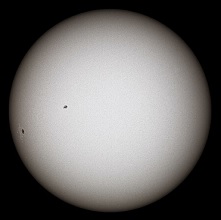|
By Lookout Staff
June 19, 2024 -- Sun worshipers can learn more about Earth's home star as Santa Monica College's Planetarium continues its Friday evening events this month.

|
The John Drescher Planetarium will also travel far beyond the sun's forces to explore the "exoplanets" orbiting far-flung stars.
The free shows take place Fridays at 8 p.m. and are preceded by a streamlined, virtual digest of the popular Night Sky Show at 7 p.m. that offers the latest news in astronomy and space exploration.
Left: The Sun filmed through a clear solar
filter (Courtesy NASA)
|
This Friday, lecturer Sarah Vincent rounds out the planetarium's “Solar System Survey" series with a look at the Sun -- "the only star in the universe with a planetary system where we know life exists."
The hot glowing ball of hydrogen and helium that sustains life on Earth is actually "a middle mass star in the outer reaches of the Milky Way," according to event organizers.
If fact, NASA notes that the Sun -- which is about 100 times wider than Earth -- is "only an average star in terms of its size." Stars "100 times larger have been found," and many solar systems have more than one star.
The 4.5-billion-year-old Sun is about 93 million miles from Earth, reaches temperatures of 27 million °F and its core is eight times more dense than gold, according to NASA.
On Friday, June 28, Vincent presents “Deep Sky Deep Dive: Understanding Exoplanets,” a look at planets beyond Earth’s solar system.
A relatively new discovery, the first exoplanet was confirmed in 1992, according to the planetarium.
"Since then, with the help of missions like Kepler and TESS, more than 5,000 have been confirmed" -- from the least massive, which is about twice the size of the moon, to the most massive, which is some 30 times the mass of Jupiter.
The first detection of an exoplanet in 1988 intensified interest in finding planets that orbit in a star's "habitable zone," making it conducive to supporting extraterrestrial life and eventually leading to headlines proclaiming “Water World Discovered.”
Vincent will explore where the exoplanets are, how they form and what they can teach about Earth and its solar system.
Planetarium lecturers are currently using the Zoom platform to present shows while the actual on-campus planetarium remains closed due to the COVID-19 pandemic.
To attend the shows, the Zoom software must be installed on the viewer’s computer. A free download is available at zoom.com.
"The shows include the chance to chat with the planetarium lecturers and ask questions related to astronomy and space exploration," planetarium officials said.
More information is available online at smc.edu/planetarium or by calling 310-434-3005. Shows are subject to change or cancellation without notice.
|